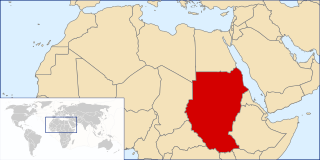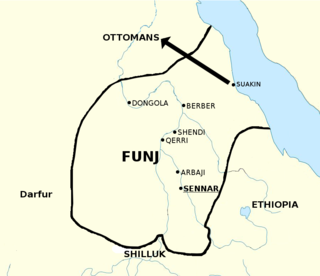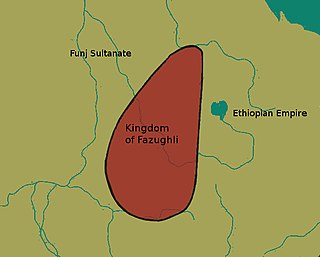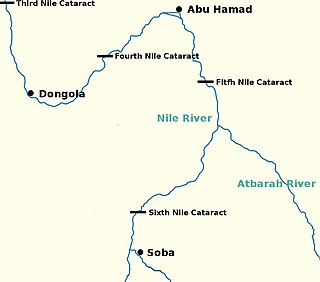Related Research Articles

Sudan, officially the Republic of the Sudan, is a country in Northeast Africa. It borders the countries of Central African Republic, Chad, Egypt, Eritrea, Ethiopia, Libya, South Sudan, and the Red Sea. It has a population of 44.91 million people as of 2021 and occupies 1,886,068 square kilometres, making it Africa's third-largest country by area, and the third-largest by area in the Arab League. It was the largest country by area in Africa and the Arab League until the secession of South Sudan in 2011, since which both titles have been held by Algeria. Its capital is Khartoum and its most populated city is Omdurman.

The history of Sudan includes that of both the territory that composes Republic of Sudan, South Sudan as well as that of a larger region known by the term "Sudan". The term is derived from Arabic: بلاد السودان bilād as-sūdān, or "land of the black people", and can be used more loosely of West and Central Africa in general, especially the Sahel.

Gezira, also spelt Al Jazirah, is one of the 18 states of Sudan. The state lies between the Blue Nile and the White Nile in the east-central region of the country. It has an area of 27,549 km2. The name comes from the Arabic word for island. Wad Madani is the capital of the state. Gezira is known as an irrigated cotton-producing state as it is a well-populated area that is suitable for agriculture.

The Funj Sultanate, also known as Funjistan, Sultanate of Sennar or Blue Sultanate due to the traditional Sudanese convention of referring to black people as blue was a monarchy in what is now Sudan, northwestern Eritrea and western Ethiopia. Founded in 1504 by the Funj people, it quickly converted to Islam, although this embrace was only nominal. Until a more orthodox Islam took hold in the 18th century, the state remained an "African-Nubian empire with a Muslim façade". It reached its peak in the late 17th century, but declined and eventually fell apart in the 18th and 19th centuries. In 1821, the last sultan, greatly reduced in power, surrendered to the Ottoman Egyptian invasion without a fight.
The Funj are an ethnic group in present-day Sudan. The Funj set up the Funj Sultanate with Abdallah Jamma and ruled the area for several centuries. The Funj rose in southern Nubia and had overthrown the remnants of the old Christian kingdom of Alodia. In 1504 a Funj leader named Amara Dunqas, founded the Black Sultanate at Sannar. The Black Sultanate soon became the keystone of the Funj Empire.

Alodia, also known as Alwa, was a medieval kingdom in what is now central and southern Sudan. Its capital was the city of Soba, located near modern-day Khartoum at the confluence of the Blue and White Nile rivers.
Taqali was a state of Nuba peoples which existed in the Nuba Mountains, in modern-day central Sudan. It is believed to have been founded in the eighteenth century, though oral traditions suggest its formation two centuries earlier. Due in part to its geographic position on a plateau surrounded by desert, Taqali was able to maintain its independence for some 130 years despite the presence of hostile neighbors. It was conquered by Sudanese Mahdists in 1884 and restored as a British client state in 1889. Its administrative power ended with the 1969 Sudanese coup, though the Makk of Taqali, its traditional leader, retains ceremonial power in the region.
Badi IV, also known as Badi abu Shilluk, was a ruler of the Kingdom of Sennar.

The Islamization of the Sudan region (Sahel) encompasses a prolonged period of religious conversion, through military conquest and trade relations, spanning the 8th to 16th centuries.
David Reubeni (1490–1535/1541?) was a Jewish political activist, described by the Shengold Jewish Encyclopedia as "half-mystic, half-adventurer." Although some scholars are reluctant to believe his claims to nobility, citing suspicions of fraud behind such claims, in November of 1525 he was nevertheless given an audience with the king, accompanied with a letter of recommendation from Pope Clement VII, and had always insisted that he was the son of a deceased monarch, and that he was the Minister of that kingdom's War Department, now governed by his elder brother, King Joseph of Ḥabor. According to Reubeni's own story this kingdom had 300,000 "Israelite" subjects. The king of Portugal, impressed by the idea, had initially agreed to supply Reubeni with Portuguese arms, but after five months, Reubeni fell into ill-repute with the king of Portugal, who perhaps distrusted his motives, and was asked by the king to leave his kingdom.
The Battle of the Dindar River was fought near the Dinder River in 1738, between the forces of the Ethiopian Emperor Iyasu II and the Sennar army under King Badi IV. The battle was a disaster for the Ethiopians and for Iyasu.
Abd al-Qadir II was a ruler of the Kingdom of Sennar. According to James Bruce, he was the son of Unsa I, whom Bruce describes as "a weak and ill-inclined man". While he was ruler of Sennar, Emperor Susenyos of Ethiopia sent to Abd al-Qadir a nagarit, or kettle-drum, richly decorated with gold, which was one of the traditional emblems of an Ethiopian negus or king; in return, Abd al-Qadir sent Susenyos a trained hunting falcon. Shortly after this diplomatic exchange, he was deposed by his brother Adlan.

Badi VII was the last ruler of the Funj Sultanate.

Nasir was a Hamaj regent under the Funj Sultanate of Sennar. He was the son of Badi IV, the previous ruler.

The Shilluk Kingdom, dominated by the Shilluk people, was located along the left bank of the White Nile river in what is now South Sudan and southern Sudan. Its capital and royal residence was in the town of Fashoda. According to Shilluk folk history and neighboring accounts, the kingdom was founded by Nyikang, who probably lived in the second half of the 15th century. As the only Nilotic people, the Shilluk managed to establish a centralized kingdom that reached its apogee in the late 18th and early 19th centuries, during the decline of the northern Funj Sultanate. In the 19th century, the Shilluk were affected by military assaults from the Ottoman Empire, resulting in the destruction of the kingdom in the early 1860s. The Shilluk king is currently not an independent political leader, but a traditional chieftain within the governments of South Sudan and Sudan. The current Shilluk king is His Majesty Reth Kwongo Dak Padiet who ascended to the throne in 1993.
The Hamaj Regency was a political order in the region of modern-day central Sudan from 1762 to 1821. During this period the ruling family of the Funj Sultanate of Sennar continued to reign, while actual power was exercised by the regents.

The Egyptian conquest of Sudan was a major military and technical feat. Fewer than 10,000 men set off from Egypt, but, with some local assistance, they were able to penetrate 1,500 km up the Nile River to the frontiers of Ethiopia, giving Egypt an empire as large as Western Europe.

The kingdom of Fazughli was a precolonial state in what is now southeastern Sudan and western Ethiopia. Oral traditions assert its establishment to refugees from the Nubian kingdom of Alodia, after its capital Soba had fallen to Arabs or the Funj in c. 1500. Centered around the mountainous region of Fazughli on the Blue Nile and serving as a buffer between the Funj sultanate and the Ethiopian empire, the kingdom lasted until its incorporation into the Funj sultanate in 1685.

The kingdom of al-Abwab was a medieval Nubian monarchy in what is now central Sudan. Initially the most northerly province of Alodia, it appeared as an independent kingdom from 1276. Henceforth it was repeatedly recorded by Arabic sources in relation to the wars between its northern neighbour Makuria and the Egyptian Mamluk sultanate, where it generally sided with the latter. In 1367 it is mentioned for the last time, but based on pottery finds it has been suggested that the kingdom continued to exist until the 15th, perhaps even the 16th, century. During the reign of Funj king Amara Dunqas the region is known to have become part of the Funj sultanate.

The Abdallabi are people living in central Sudan who claim descent from Abdallah Jamma’a. They were an important political force between the fifteenth and eighteenth centuries. For a short time the Abdallabi succeeded in establishing an independent state, but they were defeated by the Funj Sultanate in 1504 and thereafter ruled over the Butana as vassals until the Egyptian conquest of 1820.
References
- ↑ Spaulding, Jay (1985). The Heroic Age in Sennar. Red Sea. p. 9. ISBN 978-1569022603.
- ↑ Bruce, Travels to Discover the Source of the Nile (1805 edition), vol. 4 p. 458
- ↑ E.A. Wallis Budge, A History of Ethiopia: Nubia and Abyssinia, 1928 (Oosterhout, the Netherlands: Anthropological Publications, 1970)
- ↑ S. Hillelson, "David Reubeni, an early visitor to Sennar", Sudanese Notes and Records, 16 (1933), 55-66.
- ↑ A.C.S. Peacock (2012): "The Ottomans and the Funj sultanate in the sixteenth and seventeenth centuries". Bulletin of the School of Oriental and African Studies , 75, pp. 87-111.